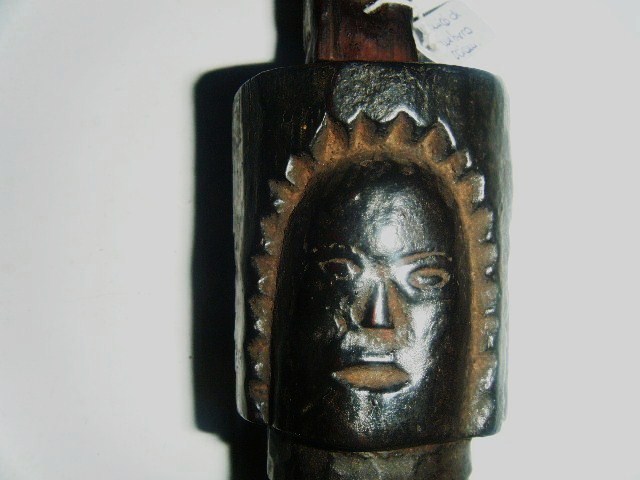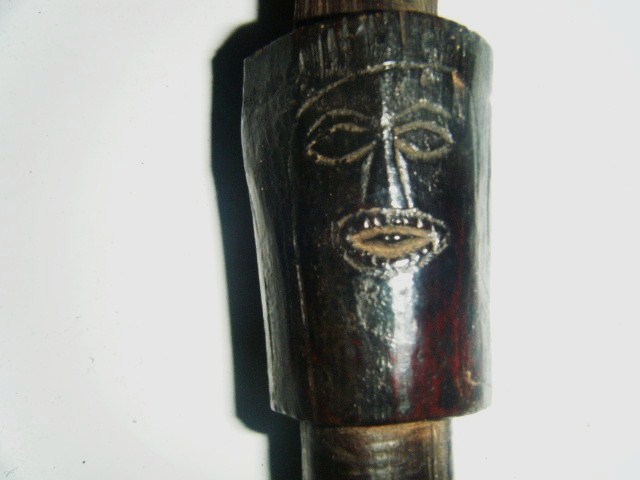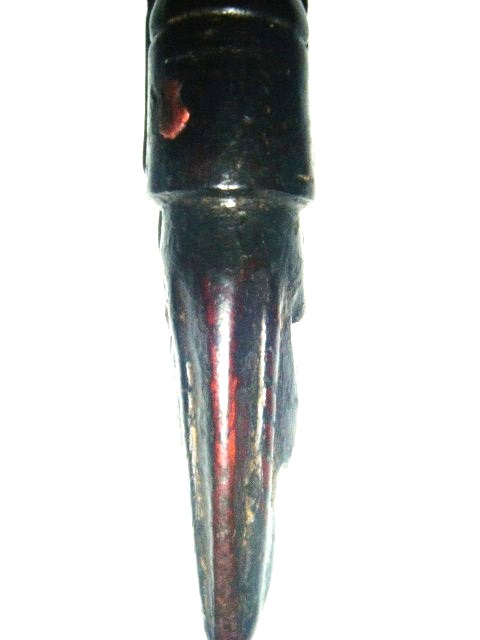ETHNOFLORENCE
SELECTION 2009
STAY IN TOUCH WITH US
SUBSCRIBE TO OUR NEWSLETTER
*******************
The double sided membrane drum Dhyangro is the peculiar, indispensable, and one of the most important, pharaphernalia of the western nepal shamans.
ETHNOFLORENCE COLLECTION AND PHOTO ARCHIVE.

Photo kindly courtesy Josh Lustig
§
“…La gente dell’Himalaya sa che le foreste sono abitate da uomini selvaggi. Ci sono le tribù dei Kusuda e dei Chepang, scoperte dagli antropologi pochi anni fa, ma anche i Ritte Jhakri, neri e pelosi, che vivono con i Suna Jhakri, acquanauti dal pelo fulvo e dorato. Consiglio di evitare i Latho Jhakri, muti e pazzi, mentre è un dono divino l’incontro con i Bon Jhakri, nani e vegetariani, verdi e caritatevoli, che insegnano le arti sciamaniche. Di notte, vicino al fuoco e ai monti più alti della terra, ho incontrato più volte chi mi giurava d’esser stato educato da queste creature dei boschi e come prova mi mostrava i regali ricevuti: pietre sonanti, cristalli e strane reliquie antropomorfe fatte di pelo e radici intrecciate. Per sopravvivere allo sterminio e a una caccia a streghe e demoni che mi ricorda quella della nostra inquisizione, molti sciamani si sono dovuti mascherare con liturgie indù e buddiste. Lo sciamano è un uomo coraggioso, un viaggiatore e un mistico che sfida l’ignoto e il mistero dell’esistenza. E’ un uomo straordinario che riesce a curarsi da dolorose malattie iniziatiche e da laceranti crisi esistenziali che lo strascinano al limite della follia. E’ un artista che inventa psicodrammi e danze estatiche per rinsaldare il gruppo e perpetuare così i miti del Clan. E’ uno psicologo contadino che ristabilisce l’equilibrio armonioso tra il “dentro” e il “fuori”, tra il corpo e l’anima, tra l’uomo e dio. E’ un medico e un erborista che conosce le piante maestre e pscichedeliche, un econauta in viaggio nella natura selvaggia in compagnia degli animali eletti a spiriti guida. Col “volo magico”, il viaggio interiore,scopre il ritmo vibratorio e le forme dell’Universo. Sale in Paradiso e scende con coraggio nel regno della Morte, la Terra del Grande Ritorno. Noi, viaggiatori verso Oriente, li abbiamo scelti come maestri del viaggio…” “Jhakri uomini con le ali” Nepal 1971, text by Italo Bertolasi for the exhibition “Viaggi a Oriente” http://www.italobertolasi.com/viaggioriente.htm , courtesy Italo Bertolasi http://www.italobertolasi.com/index.html

Nepalese Shaman holding the ritual Dhyangro and Gajo, photo courtesy Philip Adkins Collection, Huntington West Virginia USA.

Shamans holding Dhyangro drums, Rasuwa Disrict. Photo courtesy Ujjwal Pyakurel “Prayas” Katmandu Nepal.
§§§
Mountains and shamans are strictly linked together.

In Nepal the uncontaminated mountain’s peak are believed to be the house of the local divinities Pantheon.

In the western Nepal region of Solukhumbu every year during the “… primavera inoltrata, gli sciamani della regione si danno appuntamento per un pellegrinaggio. Meta di questo pellegrinaggio collettivo è Salpa, un lago montano, consacrato al culto del dio induista Shiva e considerato dimora di dèi puri e di potenti spiriti. Il dio Shiva è qui venerato come divinità locale ma soprattutto come figura di sciamano prototipico. Stando infatti ai miti e alle leggende locali, Shiva è considerato il primo sciamano divino, il fondatore dell’attività degli sciamani nonché il detentore e il dispensatore delle conoscenze esoteriche e dei poteri magici di monopolio sciamanico. Sotto questo profilo, Shiva è una figura direttamente associata alla vocazione sciamanica stessa, esperienza durante la quale il dio si paleserebbe ai neofiti nel corso di sogni e visioni dal carattere prettamente iniziatico…”
![dyn002_original_480_640_pjpeg_2638188_4a56fb2f92ed68cca7b62024f254b0a3[1]](https://ethnoflorence.wordpress.com/wp-content/uploads/2009/04/41a11-dyn009_original_480_640_pjpeg__9c14a97bbb72979867d0983ab3f8ed2c.jpg?w=788)
Nepalese phurbu
Close to the Salpa Lake there is the holy mountain of Silucha, together with Salpa this place is believed “… dalle genti del luogo la sorgente inesauribile di potenti energie invisibili, da cui dipende strettamente la vita delle comunità umane che abitano la regione, la prosperità dei villaggi e dei campi che li circondano, la salute delle persone che si trovano sotto la giurisdizione invisibile di questi luoghi sacri. La stessa diretta associazione tra il dio Shiva e la vetta montana di Silucha scaturisce naturalmente da uno degli attributi più frequenti del dio: quello di asceta solitario residente nelle remote ed elevate regioni montane. Qui, in assoluta solitudine, il dio si dedicherebbe con fervore alla pratica meditativa, coltivando gli stati più profondi del samadhi. Il pellegrinaggio, che dura vari giorni, ha il suo culmine durante una notte di luna piena. È durante questa notte che fedeli e sciamani si danno convegno: canti e danze, animano l’atmosfera per tutto l’itinerario. La musica dei tamburi sciamanici, unita a lunghe e continuate danze rituali, permettono a molti degli sciamani di cadere in una profonda condizione estatica. Una transe rituale che consente loro di dare pubblica prova dei propri poteri come chiaroveggenti e come dominatori degli elementi naturali, primo tra tutti il fuoco: maneggiare o manipolare ferri incandescenti, lambire con la propria lingua la lama arroventata di spade e pugnali è infatti la prova più tangibile del loro privilegiato status. Tutto ciò accade con il costante accompagnamento della musica, vero strumento capace di indurre una condiziona estatica e di attingere a piene mani alla fonte stessa dei poteri sciamanici…” Text courtesy MARTINO NICOLETTI “Sciamani duellanti tra le sacre montagne dell’Himalaya” (edited on Il Velino www.ilvelino.it).
Martino Nicoletti is a young Italian eclettic intellectual and well-known author of some of the most interesting books devoted to the Nepalese shamanic matter of the recent past years; texts such as “Shamanic Solitudes. Ecstasy, Madness and Spirit Possession in the Nepal Himalayas” or “The Ancestral Forest. Memory, Space and Ritual among the Kulunge Rai of Eastern Nepal” as well as “Riddum. The Voice of the Ancestors” are really important contributions for our field . http://martinonicolettivolumes.blogspot.com/
Visit the web site of Mr Nicoletti on http://martinonicoletti.blogspot.com/ .

The nepalese shaman is the bridge, the link and mediator between the real and invisible world.
The double sided membrane drum Dhjangro is the peculiar, indispensable, and one of the most important, pharaphernalia of the western nepal shamans.
Small metal objects and seeds are hooked inside the drum.
The drumstick is named Gajo.

A rich group of phurba daggers and Dhyangro handles is edited in Art Chamanique Népalais, Editions Findakly, Catalogue of the exhibition Masques & Arts Tribaux Himalayens, Galerie Le Toit Du Monde Paris 2007. http://www.letoitdumonde.net/actualites/index.html
Other items are present in Art Tribal Du Nepal, Les Editions Errance, Catalogue of the omonimous exhition at the Ile Du Demon Galerie, 1981 Paris.
The handle of the drum has the same iconogrphy of another ‘weapon’ of the Nepalese shamans, the ritual and talismanic dagger named in Tibetan phurba and in Sanskrit Kila, used to restrain evil entity and harmful occult influences.
The iconography of the Dhyangro handle can vary from one local group to another, from the geometric to the more elaborate and figurated style.
According the research of Mr Michael Oppitz this kind of artifact is an exception among the normal iconography of the Asian shamans drums, in which we can find the prevalence of single-faced streched frame drums.
The single-faced shamanic’s drum is diffused also in Nepal, Mr Oppitz divides the localization of these drums in three regional and local categories: the Dhaulagiri type localized among the North Magar Shamans, the Chantel, Bhuja Khola and the Kami of the Jajarkot district; a second tipology diffused in the Annapurna area and used by the Thakali and Gurung shamans; a third kind called of the “jungle” charachteristic of the Chepang shamans. (‘The metamorphosis of a Ritual object’ in Art Chamanique Népalais, Editions Findakly, Catalogue of the exhibition Masques & Arts Tribaux Himalayens, Galerie Le Toit Du Monde Paris 2007).
![294488696_56ebb5b713[1]](https://ethnoflorence.wordpress.com/wp-content/uploads/2009/04/b54f4-dyn002_original_500_324_pjpeg_2638188_8b4d6107e60fe1b07d3d9b718d17bfc8.jpg?w=788)
The double sided drum Dhyangro has a close morphological, but not iconographic, affinity with the analogous double sided tibetan drum called NGA-CHEN in which we can re-find an handle, in a form of lotus, installed in the wodden frame of this double sided instrument.
According Mr Eric Chazot some shamans of the western Nepal don’t use the drum themselves, so the musical accompaniment, essential for the trance, is provided by the untouchables (Art and Shamanism in the Himalayas, on Tribal Arts, 1:1/2000) http://www.tribalarts.com/feature/himalayas/
The top section of the Phurbus/Dhyangro handle is normally constituted of three faces with different expressions representing human emotions: one wrathful, one indifferent, the third Joyful.
A Vajra (in Sanskrit or rdo-rje in Tibetan) or thunderbolt-diamond is carved in the central part of the item held in place by “eternal knots”. On the top of the triangular blade of the Dhyangro handle/phurba we can normally find the representation of the sea-divinity named Makara (in sanskrit,chu-srin in Tibetan) a monster half crocodile and half elephant. Seldom the makara is replaced with the effigy of Garuda or like in one example of our collection by the really geometric representation of a ram-head. Rarely by anthropomorphic figures. In one piece of our collection the makara figure is ‘crowned’ with three human primitive faces.
According to Mr Francoise Pannier the central structure of the item, in which the Vajra is positioned vertically above the skull of the Makara could recall the myth of Indra freeing the waters of the earth and killing the serpent Vritra who had stolen all the water of the world (‘Phurbu, Un hypothese sur ses origines’ in Art Chamanique Népalais, Editions Findakly, Catalogue of the exhibition Masques & Arts Tribaux Himalayens, Galerie Le Toit Du Monde Paris 2007). http://www.letoitdumonde.net/actualites/index.html
![305816921_f959d9476e[1]](https://ethnoflorence.wordpress.com/wp-content/uploads/2009/04/5fb80-dyn002_original_445_500_pjpeg_2638188_03793547450e81059106cec55e21ad76.jpg?w=788)
The blade bursts from the jaws of the Makara and has a three sided strucure, in which are traditionally carved single or entwined pairs of snakes (naga in sanskrit, klu in Tibetan). Their talismanic presence gave to the item the power to make it rain, they are also the guardians of the water and of the undeworld.
Others subjects carved on the singles blades are the moon and the sun, the trident (Trisul) symbol of the God Shiva, representation of shamans in namaste posture or holding a Dhyangro, the ritual vase bumba, the water bowls etc.

Dhyangro handle, dark wood with superbe red reflexes.

In this Dhyangro handle the Makara’s traditional iconography is replaced by the head of an elephant crowned with three massive primitive human faces.

Makara detail.

Something of really ‘african’ in the style, patina and shape of these small but at the same time monumental unusual faces.

Detail.
The iconographic style of these three faces is similar with the same one of a black primitive nepalese mask that has a forehead and patina really similar with them.

Middle Hills mask.

Frontal view detail.

Frontal view detail.

Side A view .

Side B view.

Back side view.

Shamanic holy place of work.

Dhyangro handle, dark brown croustine patina.

Detail.

Primitive faces carved on the upper section of the item.

Comparable with the iconography of a primitive Middle Hills mask.

Shaman holding Dhyangro and Gajo, in the upper section of the blade is carved also the ritual shamanic vase bumba.
For an iconographic’s anthology of bumba simbols see on ART CHAMANIQUE NEPALAIS – NEPALESE SHAMANIC ART, pag. 80/81 Editions Findakly 2007. http://www.letoitdumonde.net/actualites/index.html

The shaman Mashini performing a ritual of benediction and protection. We can see the ritual vase bumba on the head of the man facing the shaman.
Photo courtesy Mariarosa Genitrini http://www.nepalese.it/

Interesting Dhyangro handle, excellent light brown croustine patina, the Makara subject is replaced by a powerful and extremly stylized head of ram.

Detail.

Detail.

Detail.

Ram head detail.

In this blade of the item is graved a crownching shaman in namaste posture.

Shaman in namaste posture.
This posture is comparable for example with the analogous subject present in one quintuple shamanic’s bell or in a Sulpa.

Quintuple bell.

Sulpa.
In the western Nepal we can find also wodden shamanic’s figure.

Shaman in namaste posture.

Detail.

Shaman in namaste posture, in the back side of the item is carved the tipical shaman coiffure comparable with a photo of Josh Lustig.
![305819255_338dec7fc7[1]](https://ethnoflorence.wordpress.com/wp-content/uploads/2009/04/c5c38-dyn006_original_500_446_pjpeg_2638188_9f130b87db7c9a620428b4b1bf07cfa8.jpg?w=788)
Shaman.

The head of this shaman sculpture is ‘crowned’ by the presence of two human primitive faces on the right and left side (one lost). The back side is analogous with the other shamanic sculpture.

Detail.

Detail.

Detail of one of the heads carved on the coiffure.
The Namaste posture is common in the Western Nepal primitive sculptures

Shamans holding Dhyangro drums.

Dhyangro handle, superbous red patinated wood encrusted with a light brown patina.

Detail.

Bumba detail.

Face detail.

Trisul detail.

Face detail.

Detail.

Detail.

Detail.
![dyn004_original_500_333_jpeg_2638188_0ab3dcc72a9711e5b7ea58b4bf7404fd[1]](https://ethnoflorence.wordpress.com/wp-content/uploads/2009/04/cc1e8-dyn005_original_500_333_pjpeg_2638188_7a8d3681536492d9e86cc554b3ceb28d.jpg?w=788)
Nepalese shaman holding Dhyangro Drum.

Dhyangro handle, dark wood whit a superbe light brown croustine patina. Sherpa people (?).

Face detail.

Face detail.

Detail.

Makara detail.
The wrathful expression of the face carved in this item is comparable with style of this masks of the Ethnoflorence Collection.

Mask n1.
![dyn004_original_500_341_jpeg_2638188_3ec4f9f5365c5ad48f75aa40db3dcea0[1]](https://ethnoflorence.wordpress.com/wp-content/uploads/2009/04/28361-dyn005_original_500_341_pjpeg_2638188_806de48cb3dc4f92af54149fca0fa1f3.jpg?w=788)
Shaman holding a Dhyangro.

Shaman Dhyangro.

Detail

Detail.

Detail

Dhyangro’s Drumstik Gajo.
![dyn004_original_333_500_jpeg_2638188_18b7b1ba6d8d3e96f93a8ae762d24a69[1]](https://ethnoflorence.wordpress.com/wp-content/uploads/2009/04/610fb-dyn005_original_333_500_pjpeg_2638188_627037218e21333f094e5c0f36edc497.jpg?w=788)
Shaman holding Dhyangro.

Dhyangro.

Detail.

Dhyangro drums. Photo Ethnoflorence, Ethnoflorence Himalayan Archive.

Dhyangro handle.

Superbous light brown croustine patina.

Detail.

Makara detail.

Detail.

Dhyangro handle, dark wood patina. In the place of the makara is represented the head of Garuda.

Face detail.

Face detail.

Face detail.

Detail.

Garuda head.

Detail.

Dhyangro handle, dark wood patina with red reflexes.

Face detail.

Face detail.

Face detail.

Detail.

Detail.

Shaman’s revolution.

Stylized Dhyangro handle, dark wood encrousted with a superbe dark brown patina.

Detail.

Detail.

In this blade of the handle is engraved a bumba.

Shamanic bumba holy vase.

Detail.

Detail.

Offering.

Minimal and stylized Dhyangro handle, dark wood with superbe red reflexes and encrousted patina.
The carved faces on the top of the item are four. Reutilized like phurba.

Detail.

Detail.

Detail.

Detail.

Detail.

N11 Detail view.

N11 detail view.

N11 detail view.

N11 detail view.

N11 detail view.

N11 detail view.

N11 detail view.

N11 detail view.

N11 detail view.

N11 detail view.

N11 detail view.

N11 detail view.

N11 Makara detail view.

N11 detail view.

N11 detail view.
WORK IN PROGRESS…
